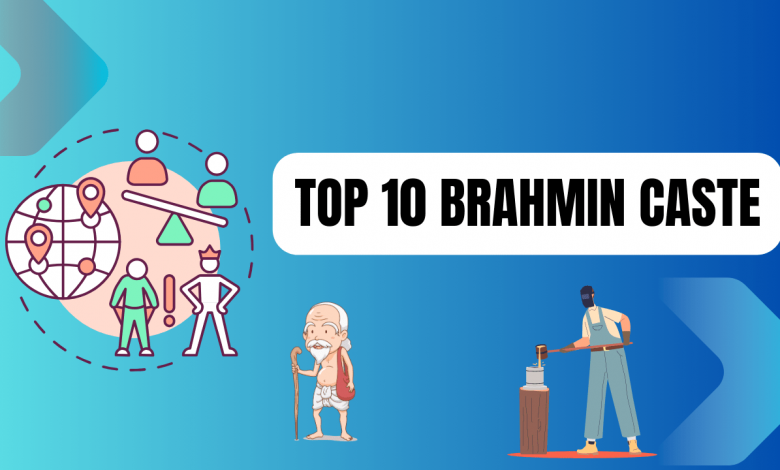Top 10 Brahmin Caste list – Latest 2024

India, with its rich tapestry of cultures and traditions, is home to a diverse array of communities. Among these, the Brahmin community holds a unique and revered place. Brahmins are often associated with knowledge, spirituality, and various intellectual pursuits. In this article, we will delve into the top 10 Brahmin castes in India, shedding light on their distinct identities and contributions to society.
Table of Contents
Top 10 Brahmin Caste list
Iyer Brahmin Caste
- Region: Predominantly from Tamil Nadu and Kerala.
- Legacy: Known for their contributions to classical music, literature, and philosophy.
- Iyer:
- Notable Figures: Eminent figures like C.V. Raman, M.S. Subbulakshmi, and R. K. Narayan belong to the Iyer community.
- Contributions: Iyers have excelled in classical Carnatic music, with many legendary vocalists and instrumentalists coming from this caste. They have also made significant contributions to Tamil literature and philosophy.
Iyengar Brahmin Caste
- Region: Primarily from Tamil Nadu and Karnataka.
- Legacy: Renowned for their devotion to Lord Vishnu and expertise in Vedic rituals.
- Geographic Concentration: Iyengar Brahmins are primarily found in the southern Indian state of Tamil Nadu and to some extent in Karnataka. Within Tamil Nadu, they are notably present in cities like Chennai, Kanchipuram, and Srirangam.
- Sects within Iyengars: Iyengar Brahmins are further divided into two major sects: Vadakalais and Thenkalais. These sects have variations in religious practices, rituals, and traditions.
- Sri Vaishnavism: Iyengar Brahmins adhere strongly to the Sri Vaishnavism tradition of Hinduism. They follow the teachings of Sri Ramanuja Acharya and place great importance on the worship of Lord Vishnu, particularly in the form of deities like Lord Ranganatha.
- Rich Heritage: Iyengar Brahmins have a rich cultural and religious heritage. They are known for their contributions to classical music, dance, philosophy, and the study of Vedas and other sacred texts.
- Language: They traditionally speak Tamil, but many are multilingual and proficient in Sanskrit due to their religious studies.
- Distinctive Cuisine: Iyengar cuisine is distinctive and known for its use of flavorful spices. Some popular dishes include “Puliogare” (tamarind rice), “Curd Rice,” and various sweets like “Mysore Pak.”
- Sriperumbudur: Sriperumbudur, the birthplace of Sri Ramanuja, holds great significance for Iyengar Brahmins, and they often visit this pilgrimage site.
- Conservative Traditions: Iyengar Brahmins tend to maintain conservative and traditional customs, particularly in religious and social matters.
- Education and Professions: Historically, Iyengar Brahmins have placed a strong emphasis on education, and many have excelled in various fields, including academia, law, and the arts.
- Iyengar Brahmins, like other Brahmin communities, have played a significant role in preserving and promoting India’s cultural and religious heritage. Their devotion to Lord Vishnu and contributions to various fields have left a lasting impact on Indian society.
Saraswat Brahmin Caste
- Region: Found in various parts of India, particularly in Goa and coastal regions.
- Legacy: Highly regarded for their proficiency in fields like astrology, medicine, and education.
- Geographic Distribution: Saraswat Brahmins are found across India, with significant populations in regions like Goa, Karnataka, and Kerala. They have a strong presence along the western coast of India.
- Historical Significance: Saraswat Brahmins have a rich history and are considered one of the oldest Brahmin communities in India. They are mentioned in ancient texts like the Rigveda.
- Cultural Richness: Saraswat Brahmins have a vibrant cultural heritage. They are known for their contributions to classical music, dance, and art forms. Many famous classical musicians and artists belong to this community.
- Cuisine: Saraswat Brahmins have a distinct cuisine known as Saraswat cuisine. It is characterized by the use of coconut, rice, and a variety of spices. Seafood also plays a significant role in their traditional dishes.
- Language: Konkani is the primary language spoken by Saraswat Brahmins. However, due to their widespread diaspora, they may also speak other regional languages.
- Religious Practices: Like other Brahmin communities, Saraswat Brahmins are known for their adherence to Vedic rituals and practices. They often take up priestly roles in temples.
- Diaspora: Over the years, many Saraswat Brahmins have migrated to different parts of India and the world. They have maintained their cultural and religious identity even in distant lands.
Bengali Brahmin Caste
- Region: Hailing from West Bengal.
- Legacy: Known for their deep involvement in arts, culture, and literature, contributing significantly to the Bengali Renaissance.
- Prominent Names: Some renowned Bengali Brahmins include Swami Vivekananda, Rabindranath Tagore, and Subhas Chandra Bose.
- Literary Heritage: Bengali Brahmins have left an indelible mark on literature, with Tagore’s poetry and prose earning him the Nobel Prize in Literature. Swami Vivekananda’s teachings on Hindu philosophy and spirituality continue to influence the world.
Bhumihar Brahmin Caste
- Region: Mainly from Bihar and Uttar Pradesh.
- Legacy: Historically, they held positions as scholars, warriors, and landowners.
- Geographic Concentration: The Bhumihar Brahmins are primarily found in the northern states of India, particularly in the state of Bihar, and parts of eastern Uttar Pradesh.
- Historical Significance: The Bhumihar Brahmins have a rich historical and social significance in the region. They have been traditionally associated with landownership, agriculture, and intellectual pursuits.
- Agricultural Heritage: Historically, many Bhumihar families were landowners and played a crucial role in agriculture. They were known for their expertise in farming and land management.
- Scholarly Traditions: Bhumihar Brahmins have a strong tradition of scholarship and have produced eminent scholars, writers, and poets over the centuries.
- Social and Cultural Contributions: They have contributed significantly to the cultural and intellectual life of Bihar and nearby regions. Many Bhumihar individuals have excelled in various fields, including politics, literature, and education.
- Prominent Figures: Several prominent figures in Indian history, such as Dr. Rajendra Prasad, the first President of India, and Jayaprakash Narayan, a freedom fighter and political leader, belonged to the Bhumihar community.
- Cultural Practices: Bhumihar Brahmins have their cultural practices, rituals, and festivals that are specific to their community.
Kanyakubja Brahmin Caste
- Region: Predominantly from North India, particularly Uttar Pradesh.
- Legacy: Recognized for their engagement in priesthood and teaching.
- Geographic Distribution: Kanyakubja Brahmins are prominent in North India, particularly in states like Uttar Pradesh and Madhya Pradesh.
- Cultural Significance: They have contributed significantly to North Indian classical music, literature, and Sanskrit scholarship.
Gaud Saraswat Brahmin Caste
- Region: Concentrated in Goa and Konkan region.
- Legacy: Known for their distinct style of worship and expertise in various sciences.
- Religious Practices: Gaud Saraswat Brahmins follow a unique form of worship, emphasizing rituals and ceremonies dedicated to deities like Lord Vishnu and Goddess Mahalakshmi.
- Culinary Traditions: They have distinctive culinary traditions, with a focus on vegetarian cuisine that features an array of spices and flavors.
Chitpavan Brahmin Caste
- Region: Originating from Maharashtra.
- Legacy: Notable for their significant role in shaping the political landscape of the region.
- Leadership Role: Chitpavan Brahmins played a vital role in the political landscape of Maharashtra during the British colonial period. Leaders like Bal Gangadhar Tilak and Gopal Krishna Gokhale were Chitpavans.
- Social Reform: They were instrumental in the social reform movements, advocating for education, women’s rights, and social equality.
Tyagi Brahmin Caste
- Region: Primarily found in North India.
- Legacy: Historically, they were involved in agriculture and landowning.
- Geographic Distribution: Tyagi Brahmins are predominantly found in the northern regions of India, particularly in the states of Uttar Pradesh, Delhi, Haryana, and Punjab.
- Historical Background: The term “Tyagi” is derived from the Sanskrit word “Tyag,” which means renunciation or sacrifice. Historically, Tyagi Brahmins were known for their ascetic and austere way of life.
- Agricultural Traditions: Many Tyagi Brahmins traditionally engaged in agriculture and farming. They were associated with landownership and land cultivation.
- Religious Significance: Tyagi Brahmins have a strong connection to Hindu religious practices and rituals. They often played roles as priests, scholars, and custodians of temples and religious institutions.
- Cultural Contributions: Over the years, Tyagi Brahmins have made contributions to various fields, including literature, music, and education. They have been part of the cultural fabric of North India.
Nagar Brahmin Caste
- Region: Scattered across India, particularly in Gujarat, Rajasthan, and Punjab.
- Legacy: Known for their proficiency in trade and business.
- Geographic Distribution: Nagar Brahmins, also known as Nagar Brahman, are primarily found in the northern regions of India, particularly in the states of Uttarakhand, Uttar Pradesh, and Himachal Pradesh. They are prevalent in towns and cities, particularly in the hilly areas.
- Occupations: Historically, Nagar Brahmins were involved in various occupations, including priesthood, teaching, and administration. They played essential roles in temples, educational institutions, and royal courts.
- Cultural Heritage: Nagar Brahmins have a rich cultural heritage, and they are known for their contributions to classical music, dance, and literature. They have preserved and promoted the traditions of classical music, including vocal and instrumental forms.
- Religious Practices: Like many other Brahmin communities, Nagar Brahmins have been custodians of Hindu religious practices. They are often involved in temple rituals, recitation of sacred texts, and teaching Vedic knowledge.
- Language: The Nagar Brahmins often speak Hindi, Sanskrit, and regional dialects. Sanskrit is considered a sacred language among this community.
- Social Structure: Nagar Brahmins, like other Brahmin communities, traditionally followed a strict social hierarchy. They were considered intellectuals and spiritual leaders in their communities. See Also Exploring “Article 15” – A Glimpse into India’s Social Realities
Brahmins, as a community, have made substantial contributions to various facets of Indian society, be it in the fields of education, spirituality, arts, or governance. Understanding the diversity within the Brahmin community and their unique legacies enriches our appreciation of India’s cultural heritage. These top 10 Brahmin castes have left an indelible mark on the country’s history and continue to play vital roles in contemporary India. See Also Top 10 Jatt castes in Pakistan & Top 10 Arain castes in Pakistan & Top 10 Rajput castes in Pakistan



